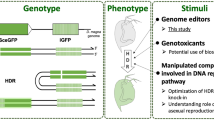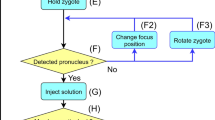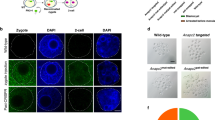Abstract
In this report we describe an easy, highly efficient transgenesis method for Xenopus. The method is very simple; a commercially available meganuclease, I-SceI, is incubated with a transgene construct carrying its recognition sites, and is subsequently microinjected into fertilized eggs. Approximately 30% (in Xenopus tropicalis) or 20% (in Xenopus laevis) of injected embryos exhibit non-mosaic, promoter-dependent transgene expression, and transgenes from the founder animals are transmitted to offspring. The method is compatible with mRNA or antisense morpholino oligonucleotide injection, and these secondary reagents can be introduced simultaneously or sequentially with a transgene to test their interaction. This high-throughput transgenic technique will be a powerful tool for studying the complex wiring of regulatory networks at the genome-wide level, as well as for facilitating genetic studies in the rapidly breeding diploid frog, X. tropicalis.
This is a preview of subscription content, access via your institution
Access options
Subscribe to this journal
Receive 12 print issues and online access
$259.00 per year
only $21.58 per issue
Buy this article
- Purchase on Springer Link
- Instant access to full article PDF
Prices may be subject to local taxes which are calculated during checkout

Similar content being viewed by others
References
Berezikov, E. & Plasterk, R.H. Camels and zebrafish, viruses and cancer: a microRNA update. Hum. Mol. Genet. 14, R183–R190 (2005).
Bejerano, G. et al. Ultraconserved elements in the human genome. Science 304, 1321–1325 (2004).
Wasserman, W.W. & Sandelin, A. Applied bioinformatics for the identification of regulatory elements. Nature Rev. Genet. 5, 276–287 (2004).
Vandepoele, K., De Vos, W., Taylor, J.S., Meyer, A. & Van de Peer, Y. Major events in the genome evolution of vertebrates: paranome age and size differ considerably between ray-finned fishes and land vertebrates. Proc. Natl. Acad. Sci. USA 101, 1638–1643 (2004).
Venkatesh, B. & Yap, W.H. Comparative genomics using fugu: a tool for the identification of conserved vertebrate cis-regulatory elements. Bioessays 27, 100–107 (2005).
Muramatsu, T., Shibata, O., Ryoki, S., Ohmori, Y. & Okumura, J. Foreign gene expression in the mouse testis by localized in vivo gene transfer. Biochem. Biophys. Res. Commun. 233, 45–49 (1997).
Momose, T. et al. Efficient targeting of gene expression in chick embryos by microelectroporation. Dev. Growth Differ. 41, 335–344 (1999).
Westerfield, M., Wegner, J., Jegalian, B.G., DeRobertis, E.M. & Puschel, A.W. Specific activation of mammalian Hox promoters in mosaic transgenic zebrafish. Genes Dev. 6, 591–598 (1992).
Fisher, S., Grice, E.A., Vinton, R.M., Bessling, S.L. & McCallion, A.S. Conservation of RET regulatory function from human to zebrafish without sequence similarity. Science 312, 276–279 (2006).
Sargent, T.D. & Mathers, P.H. Analysis of class II gene regulation. Methods Cell Biol. 36, 347–365 (1991).
Vize, P.D., Melton, D.A., Hemmati-Brivanlou, A. & Harland, R.M. Assays for gene function in developing Xenopus embryos. Methods Cell Biol. 36, 367–387 (1991).
Kroll, K.L. & Amaya, E. Transgenic Xenopus embryos from sperm nuclear transplantations reveal FGF signaling requirements during gastrulation. Development 122, 3173–3183 (1996).
Amaya, E. & Kroll, K.L. A method for generating transgenic frog embryos. Methods Mol. Biol. 97, 393–414 (1999).
Amaya, E., Offield, M.F. & Grainger, R.M. Frog genetics: Xenopus tropicalis jumps into the future. Trends Genet. 14, 253–255 (1998).
Offield, M.F., Hirsch, N. & Grainger, R.M. The development of Xenopus tropicalis transgenic lines and their use in studying lens developmental timing in living embryos. Development 127, 1789–1797 (2000).
Hirsch, N., Zimmerman, L.B. & Grainger, R.M. Xenopus, the next generation: X. tropicalis genetics and genomics. Dev. Dyn. 225, 422–433 (2002).
Hirsch, N. et al. Xenopus tropicalis transgenic lines and their use in the study of embryonic induction. Dev. Dyn. 225, 522–535 (2002).
Khokha, M.K. et al. Techniques and probes for the study of Xenopus tropicalis development. Dev. Dyn. 225, 499–510 (2002).
Duellman, W.E. & Trueb, L. Biology of Amphibians (McGrawHill, New York, 1986).
Tymowska, J. Karyotype analysis of Xenopus tropicalis Gray, Pipidae. Cytogenet. Cell Genet. 12, 297–304 (1973).
de Sa, R.O. & Hillis, D.M. Phylogenetic relationships of the pipid frogs Xenopus and Silurana: an integration of ribosomal DNA and morphology. Mol. Biol. Evol. 7, 365–376 (1990).
Allen, B.G. & Weeks, D.L. Transgenic Xenopus laevis embryos can be generated using φC31 integrase. Nature Methods 2, 975–979 (2005).
Thermes, V. et al. I-SceI meganuclease mediates highly efficient transgenesis in fish. Mech. Dev. 118, 91–98 (2002).
Ogino, H., McConnell, W.B. & Grainger, R.M. Highly efficient transgenesis in Xenopus tropicalis using I-SceI meganuclease. Mech. Dev. 123, 103–113 (2006).
Pan, F.C., Chen, Y., Loeber, J., Henningfeld, K. & Pieler, T. I-SceI meganuclease-mediated transgenesis in Xenopus. Dev. Dyn. 235, 247–252 (2006).
Jacquier, A. & Dujon, B. An intron-encoded protein is active in a gene conversion process that spreads an intron into a mitochondrial gene. Cell 41, 383–394 (1985).
Nieuwkoop, P.D. & Faber, J. Normal Table of Xenopus laevis (North-Holland Publishing Company, Amsterdam, 1967).
Uchikawa, M., Ishida, Y., Takemoto, T., Kamachi, Y. & Kondoh, H. Functional analysis of chicken Sox2 enhancers highlights an array of diverse regulatory elements that are conserved in mammals. Dev. Cell. 4, 509–519 (2003).
Sandelin, A. et al. Arrays of ultraconserved non-coding regions span the loci of key developmental genes in vertebrate genomes. BMC Genomics 5, 99 (2004).
de la Calle-Mustienes, E. et al. A functional survey of the enhancer activity of conserved non-coding sequences from vertebrate Iroquois cluster gene deserts. Genome Res. 15, 1061–1072 (2005).
Plessy, C., Dickmeis, T., Chalmel, F. & Strahle, U. Enhancer sequence conservation between vertebrates is favoured in developmental regulator genes. Trends Genet. 21, 207–210 (2005).
Woolfe, A. et al. Highly conserved non-coding sequences are associated with vertebrate development. PLoS Biol. 3, e7 (2005).
Chae, J., Zimmerman, L.B. & Grainger, R.M. Inducible control of tissue-specific transgene expression in Xenopus tropicalis transgenic lines. Mech. Dev. 117, 235–241 (2002).
Hartley, K.O., Nutt, S.L. & Amaya, E. Targeted gene expression in transgenic Xenopus using the binary Gal4-UAS system. Proc. Natl. Acad. Sci. USA 99, 1377–1382 (2002).
Yu, J.K., Holland, N.D. & Holland, L.Z. Tissue-specific expression of FoxD reporter constructs in amphioxus embryos. Dev. Biol. 274, 452–461 (2004).
Sive, H., Grainger, R. & Harland, R. Early Development of Xenopus laevis: a Laboratory Manual (Cold Spring Harbor Laboratory Press, Cold Spring Harbor, 2000).
Sambrook, J. & Russell, D.W. Molecular Cloning: a Laboratory Manual (Cold Spring Harbor Laboratory Press, Cold Spring Harbor, 2001).
Hartley, K.O., Hardcastle, Z., Friday, R.V., Amaya, E. & Papalopulu, N. Transgenic Xenopus embryos reveal that anterior neural development requires continued suppression of BMP signaling after gastrulation. Dev. Biol. 238, 168–184 (2001).
Moody, S.A. & Kline, M.J. Segregation of fate during cleavage of frog (Xenopus laevis) blastomeres. Anat. Embryol. 182, 347–362 (1990).
Hill, R.E. et al. Mouse Small eye results from mutations in a paired-like homeobox-containing gene. Nature 354, 522–525 (1991).
Acknowledgements
We wish to thank V. Thermes, J. S. Joly, J. Wittbrodt and E. Amaya for kindly providing plasmids. We also thank J. Wittbrodt, T. Hollemann and A. Brandli for helpful discussions about the I-SceI procedure. We also are grateful to members of the Grainger laboratory for continuous positive discussions regarding this study. This research was supported by US National Institutes of Health grants RR13221, EY06675, EY10283 and EY17400.
Author information
Authors and Affiliations
Corresponding author
Ethics declarations
Competing interests
The authors declare no competing financial interests.
Rights and permissions
About this article
Cite this article
Ogino, H., McConnell, W. & Grainger, R. High-throughput transgenesis in Xenopus using I-SceI meganuclease. Nat Protoc 1, 1703–1710 (2006). https://doi.org/10.1038/nprot.2006.208
Published:
Issue Date:
DOI: https://doi.org/10.1038/nprot.2006.208
This article is cited by
-
A new transgenic reporter line reveals Wnt-dependent Snai2 re-expression and cranial neural crest differentiation in Xenopus
Scientific Reports (2019)
-
Meganuclease-assisted generation of stable transgenics in the sea anemone Nematostella vectensis
Nature Protocols (2017)
-
Identification of novel cis-regulatory elements of Eya1 in Xenopus laevis using BAC recombineering
Scientific Reports (2017)
-
Modeling Dominant and Recessive Forms of Retinitis Pigmentosa by Editing Three Rhodopsin-Encoding Genes in Xenopus Laevis Using Crispr/Cas9
Scientific Reports (2017)
-
Toolbox in a tadpole: Xenopus for kidney research
Cell and Tissue Research (2017)
Comments
By submitting a comment you agree to abide by our Terms and Community Guidelines. If you find something abusive or that does not comply with our terms or guidelines please flag it as inappropriate.



